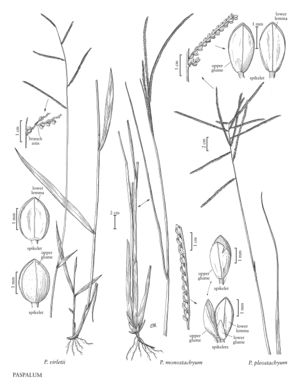Difference between revisions of "Paspalum virletii"
imported>Volume Importer |
imported>Volume Importer |
||
| (One intermediate revision by the same user not shown) | |||
| Line 39: | Line 39: | ||
|publication year= | |publication year= | ||
|special status= | |special status= | ||
| − | |source xml=https:// | + | |source xml=https://bitbucket.org/aafc-mbb/fna-data-curation/src/200273ad09963decb8fc72550212de541d86569d/coarse_grained_fna_xml/V25/V25_1486.xml |
|subfamily=Poaceae subfam. Panicoideae | |subfamily=Poaceae subfam. Panicoideae | ||
|tribe=Poaceae tribe Paniceae | |tribe=Poaceae tribe Paniceae | ||
Latest revision as of 17:57, 11 May 2021
Plants perennial; cespitose. Culms 40-75 cm, erect, not swollen at the base; nodes pubescent. Sheaths pubescent; blades to 15 cm long, 5-10 mm wide, flat, pubescent. Panicles terminal, with 3-8 racemosely arranged branches; branches 2-7 cm, spreading, terminating in a spikelet; branch axes narrow, sparsely pubescent. Spikelets 2-2.5 mm long, 1.4-1.6 mm wide, paired, imbricate, appressed to the branch axes, ovate. Lower glumes absent; upper glumes shortly pubescent, 3-veined, margins entire; lower lemmas glabrous, lacking ribs over the veins, 3-veined, margins entire; upper florets pale to stramineous or golden brown. 2n = unknown.
Discussion
Paspalum virletii grows in dry, sandy soils in disturbed habits. It is known only from Arizona, where it is considered a rare species, and from Mexico, where it also appears to be either rare or poorly collected (COTECOCA 2000).
Selected References
None.
